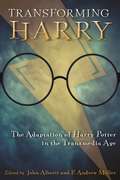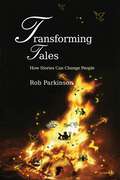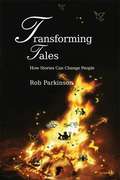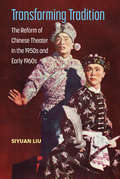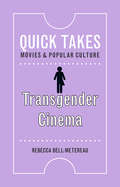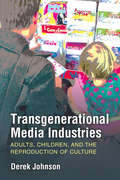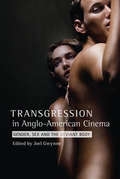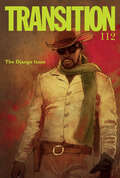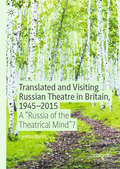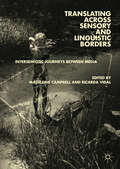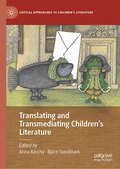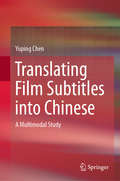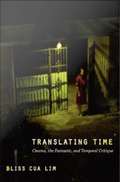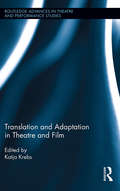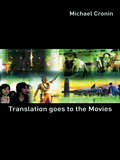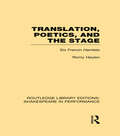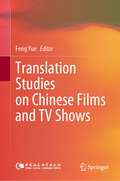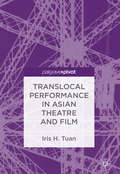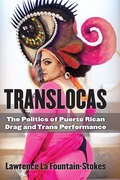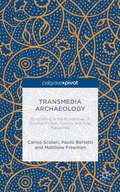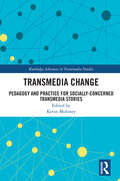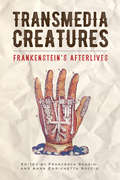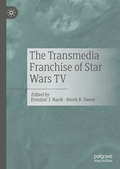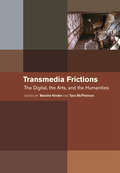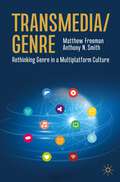- Table View
- List View
Transforming Harry: The Adaptation of Harry Potter in the Transmedia Age (Contemporary Approaches to Film and Media Series)
by Kelly Turner John Alberti Vera Cuntz-Leng P. Andrew Miller Andrew Howe Cassandra Bausman Maria Dicieanu Katharine McCain Michelle Markey Butler Liza Potts Emily DallaireTransforming Harry: The Adaptation of Harry Potter in the Transmedia Ageis an edited volume of eight essays that look at how the cinematic versions of the seven Harry Potter novels represent an unprecedented cultural event in the history of cinematic adaptation. The movie version of the first Harry Potter book, Harry Potter and the Sorcerer’s Stone, premiered in 2001, in between publication of the fourth and fifth books of this global literary phenomenon. As a result, the production and reception of both novel and movie series became intertwined with one another, creating a fanbase who accessed the series first through the books, first through the movies, and in various other combinations. John Alberti and P. Andrew Miller have gathered scholars to explore and examine the cultural, political, aesthetic, and pedagogical dimensions of this pop culture phenomenon and how it has changed the reception of both the films and books. Divided into two sections, the volume addresses both the fidelity of adaptation and the transmedia adaptations that have evolved around the creation of the books and movies. In her essay, Vera Cuntz-Leng draws on feminist film theory to explore the gaze politics and male objectification operating in the Harry Potter movies. Cassandra Bausman contends that screenwriter Steve Klove’s revision of the end of the film version of Deathly Hallows, Part II offers a more politically and ethically satisfying conclusion to the Harry Potter saga than the ending of the Rowling novel. Michelle Markey Butler’s "Harry Potter and the Surprising Venue of Literary Critiques" argues that the fan-generated memes work as a kind of popular literary analysis in three particular areas: the roles of female characters, the comparative analysis of books and films, and the comparative analysis of the Harry Potter series with other works of fantasy. While the primary focus of the collection is an academic audience, it will appeal to a broad range of readers. Within the academic community, Transforming Harry will be of interest to scholars and teachers in a number of disciplines, including film and media studies and English. Beyond the classroom, the Harry Potter series clearly enjoys a large and devoted global fan community, and this collection will be of interest to serious fans.
Transforming Tales: How Stories Can Change People
by Rob Parkinson'A very interesting and unusual book...The central theme of stories for change is challenging and exciting and it offers a good deal of wisdom about working with stories and insights into the stories themselves' â?? Mary Medlicott, storyteller, author of Shemi's Tall Tales and Cooking up a Story 'An illuminating account of the stories behind, within, above and below metaphors. The author's style is wonderfully engaging and flows beautifully from start to finish... This book will inspire anyone who works in therapeutic, creative, educational or business settings as well as being a joyful read to those who are fascinated by stories, fables and folklore. - Jaycee la Bouche, hypnotherapist, NLP confidence coach and children's relaxation teacher, Relax Kids ''This is a source of fabulous ideas and insights on the art of storytelling I will dip into again and again. Thought provoking explanations and rich examples are underpinned with biological information all of which flow easily from Rob's huge experience and skill as a storyteller. It seems as if stories really are wound into our DNA.' â?? Andy Vass, psychotherapist, coach and author of Teaching with Influence and Coaching and Mentoring for Leaders The power of story in our lives is far from adequately understood in contemporary culture. Equally the therapeutic power of storytelling, how it can quite literally entrance and even heal, has been ignored until recently. Transforming Tales reveals the true of impact of stories on our lives and how stories can create feelings of hope, take away psychological distress and even stimulate the immune system. Written by an experienced professional storyteller, this book contains over 90 short stories, from traditional fables to fascinating modern yarns, and allows readers to understand the hidden patterns storytellers use to captivate attention and learn how truths are often encapsulated in myths, jokes and fairy stories.The author focuses on the therapeutic value of stories and how they can instigate real change in people's lives. The book also reveals everything you need to know to create vibrant, memorable, original stories and short metaphors for yourself. This extraordinary journey into imagination and understanding will be an illuminating read for those professionally concerned with psychological and personal change and anyone who wants to learn more about the power and significance of stories.
Transforming Tales: How Stories Can Change People
by Rob ParkinsonWritten by an experienced professional storyteller, this book contains about 90 short stories, from traditional fables and myths to modern yarns and jokes, allowing readers to understand the hidden patterns storytellers use to captivate attention and reveal truths. The author delves into the therapeutic value of stories and how they can instigate real change in people's lives, and shows how to create original stories and short metaphors. The book's readership includes those working to facilitate psychological and personal change, including therapists, social workers, coaches, teachers, managers, and presenters, as well as storytellers.
Transforming Tradition: The Reform of Chinese Theater in the 1950s and Early 1960s
by Siyuan LiuShortly after the establishment of the People’s Republic of China in 1949, the PRC launched a reform campaign that targeted traditional song and dance theater encompassing more than a hundred genres, collectively known as xiqu. Reformers censored or revised xiqu plays and techniques; reorganized star-based private troupes; reassigned the power to create plays from star actors to the newly created functions of playwright, director, and composer; and eliminated market-oriented functionaries such as agents. While the repertoire censorship ended in the 1980s, major reform elements have remained: many traditional scripts (or parts of them) are no longer in performance; actors whose physical memory of repertoire and acting techniques had been the center of play creation, have been superseded by directors, playwrights, and composers. The net result is significantly diminished repertoires and performance techniques, and the absence of star actors capable of creating their own performance styles through new signature plays that had traditionally been one of the hallmarks of a performance school. Transforming Tradition offers a systematic study of the effects of the comprehensive reform of traditional theater conducted in the 1950s and ’60s, and is based on a decade’s worth of exhaustive research of official archival documents, wide-ranging interviews, and contemporaneous publications, most of which have never previously been referenced in scholarly research.
Transgender Cinema (Quick Takes: Movies and Popular Culture)
by Rebecca Bell-MetereauTransgender Cinema gives readers the big picture of how trans people have been depicted on screen. Beginning with a history of trans tropes in classic Hollywood cinema, from comic drag scenes in Chaplin’s The Masquerader to Garbo’s androgynous Queen Christina, and from psycho killer queers to The Rocky Horror Picture Show’s outrageous queen, it examines a plethora of trans portrayals that subsequently emerged from varied media outlets, including documentary films, television serials, and world cinema. Along the way, it analyzes milestones in trans representation, like The Crying Game, Boys Don’t Cry, Hedwig and the Angry Inch,and A Fantastic Woman. As it traces the evolution of trans people onscreen, Transgender Cinema also considers the ongoing controversies sparked by these movies and series both within LGBTQ communities and beyond. Ultimately it reveals how film and television have shaped not only how the general public sees trans people, but also how trans people see themselves.
Transgenerational Media Industries: Adults, Children, and the Reproduction of Culture
by Derek JohnsonWithin corporate media industries, adults produce children’s entertainment. Yet children, presumed to exist outside the professional adult world, make their own contributions to it—creating and posting unboxing videos, for example, that provide content for toy marketers. Many adults, meanwhile, avidly consume entertainment products nominally meant for children. Media industries reincorporate this market-disrupting participation into their strategies, even turning to adult consumers to pass fandom to the next generation. Derek Johnson presents an innovative perspective that looks beyond the simple category of “kids’ media” to consider how entertainment industry strategies invite producers and consumers alike to cross boundaries between adulthood and childhood, professional and amateur, new media and old. Revealing the social norms, reproductive ideals, and labor hierarchies on which such transformations depend, he identifies the lines of authority and power around which legacy media institutions like television, comics, and toys imagine their futures in a digital age. Johnson proposes that it is not strategies of media production, but of media reproduction, that are most essential in this context. To understand these critical intersections, he investigates transgenerational industry practice in television co-viewing, recruitment of adult comic readers as youth outreach ambassadors, media professionals’ identification with childhood, the branded management of adult fans of LEGO, and the labor of child YouTube video creators. These dynamic relationships may appear to disrupt generational and industry boundaries alike. However, by considering who media industries empower when generating the future in these reproductive terms and who they leave out, Johnson ultimately demonstrates how their strategies reinforce existing power structures. This book makes vital contributions to media studies in its fresh approach to the intersections of adulthood and childhood, its attention to the relationship between legacy and digital media industries, and its advancement of dialogue between media production and consumption researchers. It will interest scholars in media industry studies and across media studies more broadly, with particular appeal to those concerned about the current and future reach of media industries into our lives.
Transgression in Anglo-American Cinema: Gender, Sex, and the Deviant Body
by Joel GwynneSexuality within mainstream Hollywood cinema features primarily in comedy or rom-com genres, where lightness of tone permits audience engagement with what would otherwise be difficult affective terrain. Focusing on marginal productions in Anglo-American contexts, this collection explores the gendered dynamics of sex and the body, particularly embodied deviations from normative cultural scripts. It explores transgressions acted through and written on the body, and the ways in which corporeality inscribes gender discourse and reflects cultural and institutional power. Films analyzed include Mysterious Skin (2004), Shame (2011), Nymphomaniac (2013), and Dallas Buyers Club (2013). Navigating queer politics, taboo fantasy, body modification, fetishism, sex addiction, and underage sex, essays problematize understandings of adult agency, childhood innocence, and healthy desire, locating sex and gender as sites of oppression, liberation, and resistance.
Transition 112: The Django Issue (Transition #112)
by Indiana University JournalsTransition 112 Indiana University Journals
Translated and Visiting Russian Theatre in Britain, 1945–2015: A "Russia of the Theatrical Mind"?
by Cynthia MarshThis book tackles questions about the reception and production of translated and untranslated Russian theatre in post-WW2 Britain: why in British minds is Russia viewed almost as a run-of-the-mill production of a Chekhov play. Is it because Chekhov is so dominant in British theatre culture? What about all those other Russian writers? Many of them are very different from Chekhov. A key question was formulated, thanks to a review by Susannah Clapp of Turgenev’s A Month in the Country: have the British staged a ‘Russia of the theatrical mind’?
Translating across Sensory and Linguistic Borders: Intersemiotic Journeys between Media
by Ricarda Vidal Madeleine CampbellThis book analyses intersemiotic translation, where the translator works across sign systems and cultural boundaries. Challenging Roman Jakobson’s seminal definitions, it examines how a poem may be expressed as dance, a short story as an olfactory experience, or a film as a painting. This emergent process opens up a myriad of synaesthetic possibilities for both translator and target audience to experience form and sense beyond the limitations of words. The editors draw together theoretical and creative contributions from translators, artists, performers, academics and curators who have explored intersemiotic translation in their practice. The contributions offer a practitioner’s perspective on this rapidly evolving, interdisciplinary field which spans semiotics, cognitive poetics, psychoanalysis and transformative learning theory. The book underlines the intermedial and multimodal nature of perception and expression, where semiotic boundaries are considered fluid and heuristic rather than ontological. It will be of particular interest to practitioners, scholars and students of modern foreign languages, linguistics, literary and cultural studies, interdisciplinary humanities, visual arts, theatre and the performing arts.
Translating and Transmediating Children’s Literature (Critical Approaches to Children's Literature)
by Anna Kérchy Björn SundmarkFrom Struwwelpeter to Peter Rabbit, from Alice to Bilbo—this collection of essays shows how the classics of children’s literature have been transformed across languages, genres, and diverse media forms. This book argues that translation regularly involves transmediation—the telling of a story across media and vice versa—and that transmediation is a specific form of translation. Beyond the classic examples, the book also takes the reader on a worldwide tour, and examines, among other things, the role of Soviet science fiction in North Korea, the ethical uses of Lego Star Wars in a Brazilian context, and the history of Latin translation in children’s literature. Bringing together scholars from more than a dozen countries and language backgrounds, these cross-disciplinary essays focus on regularly overlooked transmediation practices and terminology, such as book cover art, trans-sensory storytelling, écart, enfreakment, foreignizing domestication, and intra-cultural transformation.
Translating Film Subtitles into Chinese: A Multimodal Study
by Yuping ChenThis book examines three metafunction meanings in subtitle translation with three research foci, i.e., the main types of cross-modal interrelation, the primary function of semiotic interplay, and the key linguistic components influencing the subtitles. It goes beyond traditional textual analysis in translation studies; approaches subtitle translation from a multimodality standpoint; and breaks through the linguistic restraints on subtitling research by underscoring the role of semiotic interplay. In the field of multimodality, this book bridges subtitling and multimodality by investigating the interweaving relationships between different semiotic modes, and their corresponding impacts on subtitle translation.
Translating Time: Cinema, the Fantastic, and Temporal Critique
by Bliss Cua LimUnder modernity, time is regarded as linear and measurable by clocks and calendars. Despite the historicity of clock-time itself, the modern concept of time is considered universal and culturally neutral. What Walter Benjamin called "homogeneous, empty time" founds the modern notions of progress and a uniform global present in which the past and other forms of time consciousness are seen as superseded. In Translating Time, Bliss Cua Lim argues that fantastic cinema depicts the coexistence of other modes of being alongside and within the modern present, disclosing multiple "immiscible temporalities" that strain against the modern concept of homogeneous time. In this wide-ranging study--encompassing Asian American video (On Cannibalism), ghost films from the New Cinema movements of Hong Kong and the Philippines (Rouge, Itim, Haplos), Hollywood remakes of Asian horror films (Ju-on, The Grudge, A Tale of Two Sisters) and a Filipino horror film cycle on monstrous viscera suckers (Aswang)--Lim conceptualizes the fantastic as a form of temporal translation. The fantastic translates supernatural agency in secular terms while also exposing an untranslatable remainder, thereby undermining the fantasy of a singular national time and emphasizing shifting temporalities of transnational reception. Lim interweaves scholarship on visuality with postcolonial historiography. She draws on Henri Bergson's understanding of cinema as both implicated in homogeneous time and central to its critique, as well as on postcolonial thought linking the ideology of progress to imperialist expansion. At stake in this project are more ethical forms of understanding time that refuse to domesticate difference as anachronism. While supernaturalism is often disparaged as a vestige of primitive or superstitious thought, Lim suggests an alternative interpretation of the fantastic as a mode of resistance to the ascendancy of homogeneous time and a starting-point for more ethical temporal imaginings.
Translation and Adaptation in Theatre and Film (Routledge Advances in Theatre & Performance Studies)
by Katja KrebsThis book provides a pioneering and provocative exploration of the rich synergies between adaptation studies and translation studies and is the first genuine attempt to discuss the rather loose usage of the concepts of translation and adaptation in terms of theatre and film. At the heart of this collection is the proposition that translation studies and adaptation studies have much to offer each other in practical and theoretical terms and can no longer exist independently from one another. As a result, it generates productive ideas within the contact zone between these two fields of study, both through new theoretical paradigms and detailed case studies. Such closely intertwined areas as translation and adaptation need to encounter each other’s methodologies and perspectives in order to develop ever more rigorous approaches to the study of adaptation and translation phenomena, challenging current assumptions and prejudices in terms of both. The book includes contributions as diverse yet interrelated as Bakhtin’s notion of translation and adaptation, Bollywood adaptations of Shakespeare’s Othello, and an analysis of performance practice, itself arguably an adaptive practice, which uses a variety of languages from English and Greek to British and International Sign-Language. As translation and adaptation practices are an integral part of global cultural and political activities and agendas, it is ever more important to study such occurrences of rewriting and reshaping. By exploring and investigating interdisciplinary and cross-cultural perspectives and approaches, this volume investigates the impact such occurrences of rewriting have on the constructions and experiences of cultures while at the same time developing a rigorous methodological framework which will form the basis of future scholarship on performance and film, translation and adaptation.
Translation goes to the Movies
by Michael CroninThis highly accessible introduction to translation theory, written by a leading author in the field, uses the genre of film to bring the main themes in translation to life. Through analyzing films as diverse as the Marx Brothers’ A Night at the Opera, The Star Wars Trilogies and Lost in Translation, the reader is encouraged to think about both issues and problems of translation as they are played out on the screen and issues of filmic representation through examining the translation dimension of specific films. In highlighting how translation has featured in both mainstream commercial and arthouse films over the years, Cronin shows how translation has been a concern of filmmakers dealing with questions of culture, identity, conflict and representation. This book is a lively and accessible text for translation theory courses and offers a new and largely unexplored approach to topics of identity and representation on screen. Translation Goes to the Movies will be of interest to those on translation studies and film studies courses.
Translation, Poetics, and the Stage: Six French Hamlets (Routledge Library Editions: Shakespeare in Performance)
by Romy HeylenThis book establishes an analytical model for the description of existing translations in their historical context within a framework suggested by systemic concepts of literature. It argues against mainstream 20th-century translation theory and, by proposing a socio-cultural model of translation, takes into account how a translation functions in the receiving culture. The case studies of successive translations of "Hamlet" in France from the eighteenth century neoclassical version of Jean-Francois Ducis to the 20th-century Lacanian, post-structuralist stage production of Daniel Mesguich show the translator at work. Each chapter focuses on a different aspect of the changing theatrical and literary norms to which translators through the ages have been bound by the expectations both of their audiences and the literary establishment.
Translation Studies on Chinese Films and TV Shows
by Feng YueThis book explores translation strategies for films and TV programs. On the basis of case studies on subtitle translations, it argues that translators are expected to take into consideration not only linguistic and cultural differences but also the limits of time and space. Based on the editor’s experience working as a translator for TV, journalist, and narrator, this book proposes employing editorial translation for TV translation. Further, in light of statistics on international audiences’ views on Chinese films, it suggests striking a balance between conveying cultural messages and providing good entertainment.
Translocal Performance in Asian Theatre and Film
by Iris H. TuanThis pivot offers an innovative, trans-local perspective on performance studies in the era of digital technology, considering a range of content from theater to opera, film, dance, and musical theatre. It examines theatre performing arts and film in terms of aesthetics, gender studies, and identity politics, and showcases the value of human accomplishments in theatre and film and their representative artistic works. It also addresses key issues within performance studies, such as gender, class, race, ethnicity, identity, and how minorities portray their ethnicity stories. This book links the trans-national and the trans-local and considers how emerging mobile geographies and new methodologies of interpreting performance in theatre and film reflect the transformations of our understanding of geopolitical time and space.
Translocas: The Politics of Puerto Rican Drag and Trans Performance (Triangulations: Lesbian/Gay/Queer Theater/Drama/Performance)
by Lawrence La Fountain-StokesTranslocas focuses on drag and transgender performance and activism in Puerto Rico and its diaspora. Arguing for its political potential, Lawrence La Fountain-Stokes explores the social and cultural disruptions caused by Latin American and Latinx “locas” (effeminate men, drag queens, transgender performers, and unruly women) and the various forms of violence to which queer individuals in Puerto Rico and the U.S. are subjected. This interdisciplinary, auto-ethnographic, queer-of-color performance studies book explores the lives and work of contemporary performers and activists including Sylvia Rivera, Nina Flowers, Freddie Mercado, Javier Cardona, Jorge Merced, Erika Lopez, Holly Woodlawn, Monica Beverly Hillz, Lady Catiria, and Barbra Herr; television programs such as RuPaul’s Drag Race; films such as Paris Is Burning, The Salt Mines, and Mala Mala; and literary works by authors such as Mayra Santos-Febres and Manuel Ramos Otero. Lawrence La Fountain-Stokes, a drag performer himself, demonstrates how each destabilizes (and sometimes reifies) dominant notions of gender and sexuality through drag and their embodied transgender expression. These performances provide a means to explore and critique issues of race, class, poverty, national identity, and migratory displacement while they posit a relationship between audiences and performers that has a ritual-like, communal dimension. The book also analyzes the murders of Jorge Steven López Mercado and Kevin Fret in Puerto Rico, and invites readers to challenge, question, and expand their knowledge about queer life, drag, trans performance, and Puerto Rican identity in the Caribbean and the diaspora. The author also pays careful attention to transgender experience, highlighting how trans activists and performers mold their bodies, promote social change, and create community in a context that oscillates between glamour and abjection.
Transmedia Archaeology: Storytelling in the Borderlines of Science Fiction, Comics and Pulp Magazines
by Carlos A. Scolari Paolo Bertetti Matthew FreemanIn this book, the authors examine manifestations of transmedia storytelling in different historical periods and countries, spanning the UK, the US and Argentina. It takes us into the worlds of Conan the Barbarian, Superman and El Eternauta, introduces us to the archaeology of transmedia, and reinstates the fact that it's not a new phenomenon.
Transmedia Change: Pedagogy and Practice for Socially-Concerned Transmedia Stories (Routledge Advances in Transmedia Studies)
by Kevin MoloneyThis book examines and illustrates the use of design principles, design thinking, and other empathy research techniques in university and public settings, to plan and ethically target socially-concerned transmedia stories and evaluate their success through user experience testing methods. All media industries continue to adjust to a dispersed, diverse, and dilettante mediascape where reaching a large global audience may be easy but communicating with a decisive and engaged public is more difficult. This challenge is arguably toughest for communicators who work to engage a public with reality rather than escape. The chapters in this volume outline the pedagogy and practice of design, empathy research methods for story development, transmedia logics for socially-concerned stories, development of community engagement and the embrace of collective narrative, art and science research collaboration, the role of mixed and virtual reality in prosocial communication, ethical audience targeting, and user experience testing for storytelling campaigns. Each broad topic includes case examples and full case studies of each stage in production. Offering a detailed exploration of a fast-emerging area, this book will be of great relevance to researchers and university teachers of socially-concerned transmedia storytelling in fields such as journalism, documentary filmmaking, education, and activism.
Transmedia Creatures: Frankenstein’s Afterlives
by Lidia De Michelis Eleanor Beal Gino Roncaglia Claire Nally Claudia Gualtieri Federico Meschini Enrico Reggiani Diego Saglia Daniele Pio Buenza Ruth Heholt Andrew McInnes Janet LarsonOn the 200th anniversary of the first edition of Mary Shelley’s Frankenstein, Transmedia Creatures presents studies of Frankenstein by international scholars from converging disciplines such as humanities, musicology, film studies, television studies, English and digital humanities. These innovative contributions investigate the afterlives of a novel taught in a disparate array of courses - Frankenstein disturbs and transcends boundaries, be they political, ethical, theological, aesthetic, and not least of media, ensuring its vibrant presence in contemporary popular culture. Transmedia Creatures highlights how cultural content is redistributed through multiple media, forms and modes of production (including user-generated ones from “below”) that often appear synchronously and dismantle and renew established readings of the text, while at the same time incorporating and revitalizing aspects that have always been central to it. The authors engage with concepts, value systems and aesthetic-moral categories—among them the family, horror, monstrosity, diversity, education, risk, technology, the body—from a variety of contemporary approaches and highly original perspectives, which yields new connections. Ultimately, Frankenstein, as evidenced by this collection, is paradoxically enriched by the heteroglossia of preconceptions, misreadings, and overreadings that attend it, and that reveal the complex interweaving of perceptions and responses it generates. Published by Bucknell University Press. Distributed worldwide by Rutgers University Press.
The Transmedia Franchise of Star Wars TV
by Dominic J. Nardi Derek R. SweetWhile previous work on the Star Wars universe charts the Campbellian mythic arcs, political representations, and fan reactions associated with the films, this volume takes a transmedial approach to the material, recognizing that Star Wars TV projects interact with and relate to other Star Wars texts. The chapters in this volume take as a basic premise that the televisual entrants into the Star Wars transmedia storyworld are both important texts in the history of popular culture and also key to understanding how the Star Wars franchise—and, thus, industry-wide transmedia storytelling strategies—developed. The book expands previous work to consider television studies and sharp cultural criticism together in an effort to bring both long-running popular series, long-ignored texts, and even toy commercials to bear on the franchise’s complex history.
Transmedia Frictions
by Marsha Kinder Tara McphersonEditors Marsha Kinder and Tara McPherson present an authoritative collection of essays on the continuing debates over medium specificity and the politics of the digital arts. Comparing the term "transmedia" with "transnational," they show that the movement beyond specific media or nations does not invalidate those entities but makes us look more closely at the cultural specificity of each combination. In two parts, the book stages debates across essays, creating dialogues that give different narrative accounts of what is historically and ideologically at stake in medium specificity and digital politics. Each part includes a substantive introduction by one of the editors. Part 1 examines precursors, contemporary theorists, and artists who are protagonists in this discursive drama, focusing on how the transmedia frictions and continuities between old and new forms can be read most productively: N. Katherine Hayles and Lev Manovich redefine medium specificity, Edward Branigan and Yuri Tsivian explore nondigital precursors, Steve Anderson and Stephen Mamber assess contemporary archival histories, and Grahame Weinbren and Caroline Bassett defend the open-ended mobility of newly emergent media. In part 2, trios of essays address various ideologies of the digital: John Hess and Patricia R. Zimmerman, Herman Gray, and David Wade Crane redraw contours of race, space, and the margins; Eric Gordon, Cristina Venegas, and John T. Caldwell unearth database cities, portable homelands, and virtual fieldwork; and Mark B.N. Hansen, Holly Willis, and Rafael Lozano-Hemmer and Guillermo Gómez-Peña examine interactive bodies transformed by shock, gender, and color. An invaluable reference work in the field of visual media studies, Transmedia Frictions provides sound historical perspective on the social and political aspects of the interactive digital arts, demonstrating that they are never neutral or innocent.
Transmedia/Genre: Rethinking Genre in a Multiplatform Culture
by Matthew Freeman Anthony N. SmithThis book brings genre back to the forefront of the current transmedia trend. Genres are perhaps the most innately transmedial of media constructs, formed as they are from all kinds of industrial, technological and discursive phenomena. Yet, few have considered how genre works in a multiplatform context. This book does precisely that, making a uniquely transmedial contribution to the study of genre in the age of media convergence. The book interrogates how industrial, technological and participatory transformations of digital platforms and emerging technologies reshape workings of genre. The authors consider franchises such as Star Wars, streaming platforms such as Netflix, catch-up services such as ITV Hub, creative technologies such as virtual reality, and beyond. In setting the stage for the revival of genre theory in contemporary transmedia scholarship, this book pushes forward understandings of multiplatform media and the emerging form and function of genre across contemporary culture.
